Physical Address
304 North Cardinal St.
Dorchester Center, MA 02124
Cutaneous mesenchymal tumors are considered separately in this chapter because many of the tumors are either unique to or predominate in the skin or show specific features when presenting in the skin.
The morphologic spectrum of cutaneous soft tissue tumors is wide and varied, and it includes spindle cell, epithelioid, myxoid, and pleomorphic patterns, in addition to clear cell features. The largest morphologic category is that of spindle cell tumors, with benign fibrous histiocytoma being the most common cutaneous mesenchymal tumor overall.
The diagnosis of cutaneous mesenchymal tumors may be challenging due to the significant morphologic overlap between tumors. Furthermore, although the vast majority of cutaneous mesenchymal tumors are benign, distinction from malignant tumors may be difficult because distinguishing features may be subtle and difficult to assess, especially on limited samples (e.g., shave or punch biopsies). Conversely, tumors with histologic features of malignancy may behave in an entirely benign fashion when confined to the dermis (e.g., cutaneous atypical smooth muscle tumors and atypical fibroxanthoma [AFX]). Of particular importance is the consideration of melanocytic tumors and poorly differentiated squamous cell carcinoma in the differential diagnosis of cutaneous mesenchymal neoplasms. It is imperative to pay attention to subtle clinical as well as morphologic clues, in addition to the inclusion of markers of melanocytic and epithelial differentiation in an immunohistochemical panel. Desmoplastic and neurotropic melanoma as well as desmoplastic and spindle cell or sarcomatoid squamous cell carcinoma should always enter the differential diagnosis of tumors presenting on sun-exposed skin of the elderly. They are notoriously difficult to diagnose, and often multiple immunohistochemical markers are necessary to detect their line of differentiation. The presence of S-100 protein ( Table 15.1 ) and, to a lesser extent, keratin expression may also be seen in various cutaneous mesenchymal tumors, further complicating the issue. In contrast to deep-seated soft tissue tumors, cutaneous tumors less frequently display specific diagnostically helpful cytogenetic or molecular genetic findings.
| Clinical Presentation | Histologic Features | Immunohistochemistry | |
|---|---|---|---|
| Melanoma |
|
|
|
| Cutaneous myoepithelioma |
|
|
|
| Dermal nerve sheath myxoma |
|
|
|
| Granular cell tumor |
|
|
|
| Solitary circumscribed neuroma |
|
|
|
| Neurofibroma |
|
|
|
| Malignant peripheral nerve sheath tumor |
|
|
|
| Clear cell sarcoma |
|
|
|
| Langerhans cell histiocytosis |
|
|
|
| Rosai-Dorfman disease |
|
|
|
In keeping with the overall structure of this book, tumors in this chapter are organized according to histologic patterns rather than lines of differentiation. Exceptions are cutaneous adipocytic tumors, which are addressed separately in brief at the end of the chapter, as well as cutaneous vascular tumors, which are discussed together with vascular tumors at other sites in Chapter 13 . The differential diagnosis of cutaneous mesenchymal tumors according to histologic pattern is further emphasized in accompanying tables.
Wide morphologic spectrum of cutaneous mesenchymal tumors
Significant morphologic overlap between cutaneous mesenchymal tumors
Subtle features of malignancy, especially on partial and superficial samples (shave or punch biopsy)
Histologic features of malignancy are not necessarily associated with aggressive clinical behavior in certain tumors when confined to dermis
Melanoma and poorly differentiated squamous cell carcinoma should always be considered in the differential diagnosis
Clinical features and presentation warrant attention
Careful interpretation of immunohistochemical findings
Fibrous histiocytomas are the most common mesenchymal tumors arising in the skin. They show a wide morphologic spectrum, and multiple variants are recognized ( Table 15.2 ). Awareness of and familiarity with these variants of fibrous histiocytoma are important because their morphologic features can easily be mistaken for other lesions, including tumors with more sinister prognoses ( Table 15.3 ). Furthermore, some of the morphologic variants are associated with specific clinical features and behavior. Epithelioid fibrous histiocytoma is described later in the chapter in the section “Epithelioid Tumors.” A deep variant has also been described in soft tissue and is discussed separately in Chapter 3 . On a molecular level, fusion genes, mainly involving protein kinase C (PKC) isoforms or the ALK gene have been identified in a subset of these tumors. Although PKC fusion genes are seen across the morphologic variants of fibrous histiocytoma, ALK gene rearrangements are most prevalent in the epithelioid variant.
| Clinical Presentation | Histology | Behavior | |
|---|---|---|---|
| Dermatofibroma |
|
|
Simple excision curative |
| Hemosiderotic FH |
|
Same as dermatofibroma but abundant hemosiderin-laden histiocytes and giant cells | Simple excision curative |
| Atrophic FH | Same as dermatofibroma | Same as dermatofibroma but less cellular and prominent stromal hyalinization | Simple excision curative |
| Clear cell FH | Same as dermatofibroma | Same as dermatofibroma but abundant clear cell change of tumor cells | Simple excision curative |
| Granular cell FH | Same as dermatofibroma | Same as dermatofibroma but abundant granular cell change of tumor cells | Simple excision curative |
| Palisading FH |
|
Same as dermatofibroma but striking nuclear palisading of tumor cells reminiscent of Verocay bodies | Simple excision curative |
| Epithelioid FH |
|
|
Simple excision curative |
| Lipidized FH |
|
Same as dermatofibroma but marked lipidization of tumor cells with prominent surrounding stromal hyalinization | Simple excision curative |
| Cellular FH |
|
|
Local nondestructive recurrence in 20% Distant metastasis exceptional |
| Aneurysmal FH |
|
Same as dermatofibroma and cellular fibrous histiocytoma but central blood-filled cystic space and abundant hemosiderin deposition | Local nondestructive recurrence in 20% Distant metastasis exceptional |
| Atypical FH |
|
Same as dermatofibroma but presence of marked nuclear pleomorphism and hyperchromasia | Local nondestructive recurrence in 20% Distant metastasis exceptional |
| Clinical Presentation | Histologic Features | Immunohistochemistry | |
|---|---|---|---|
| Dermatomyofibroma |
|
|
|
| Pilar leiomyoma |
|
|
|
| Myofibroma |
|
|
|
| Neurofibroma |
|
|
|
| Scar | History of prior trauma |
|
|
| Sclerosing blue nevus |
|
|
|
| Spindle cell atypical fibroxanthoma |
|
|
|
| Kaposi sarcoma |
|
|
|
| Spindle cell hemangioma |
|
|
|
| Dermatofibrosarcoma protuberans |
|
|
|
| Spindle cell angiosarcoma |
|
|
|
| Leiomyosarcoma |
|
|
|
| Malignant peripheral nerve sheath tumor |
|
|
|
| Spindle cell and desmoplastic melanoma |
|
|
|
| Spindle cell squamous cell carcinoma |
|
|
|
Dermal benign fibrous histiocytoma (dermatofibroma) occurs over a wide age range but shows a predilection for adults in the third and fourth decades. Women are more frequently affected, and the extremities are favored sites, followed by the trunk. Head and neck involvement is rare. The clinical presentation is of a solitary, relatively circumscribed and well-demarcated firm papule or plaque measuring less than 1 cm in diameter. Dermatofibromas are often hyperpigmented or red and may occasionally appear bluish or black. They are rarely multiple. An eruptive variant has been reported in association with immunosuppression.
Dermatofibroma is a relatively circumscribed dermal-based tumor with a vaguely nodular appearance ( Fig. 15.1 ). It is composed of short spindle cells in a haphazard arrangement. Tumor cellularity is higher toward the center of the lesion and reduced at its periphery, where tumor cells surround individual collagen bundles, also referred to as entrapment of dermal collagen ( Fig. 15.2 ). A storiform growth pattern may be a focal feature. Varying numbers of foamy histiocytes and multinucleated (including Touton) giant cells may be present ( Fig. 15.3 ), and an accompanying admixed chronic inflammatory infiltrate composed of lymphocytes and plasma cells is frequently seen. Hemosiderin deposition may be present within histiocytes and can be extensive in the hemosiderotic variant (“sclerosing hemangioma”) ( Fig. 15.4 ). Dermatofibroma is centered in and largely confined to the dermis, but focal extension into superficial subcutis is not unusual due to growth along preexisting fibrous septa ( Fig. 15.5 ). A pushing growth pattern into superficial subcutis is less frequently observed. Dermatofibroma typically spares the papillary dermis, and hyperplasia of the overlying epidermis often also showing basal cell layer hyperpigmentation is a characteristic feature ( Fig. 15.6 ). A basaloid proliferation reminiscent of immature hair follicles or trichoblastoma may also be seen ( Fig. 15.7 ). Rarely, tumor cells show extensive clear cell change (clear cell fibrous histiocytoma). Nuclear palisading reminiscent of Verocay bodies has been reported to occur predominantly in tumors of acral locations and is referred to as the palisading variant ( Fig. 15.8 ). Extensive granular cell change may rarely be seen (granular cell dermatofibroma) ( Fig. 15.9 ). Prominent lipidization of tumor cells with surrounding stromal hyalinization is a feature seen predominantly in tumors arising on the lower extremity, particularly the ankle (“lipidized” or “ankle-type” fibrous histiocytoma) ( Fig. 15.10 ). Due to the extensive lipid accumulation, these tumors have a yellowish clinical appearance. Long-standing lesions are characterized by hypocellularity and stromal hyalinization, predominantly affecting the center of the lesion (atrophic variant) ( Fig. 15.11 ).
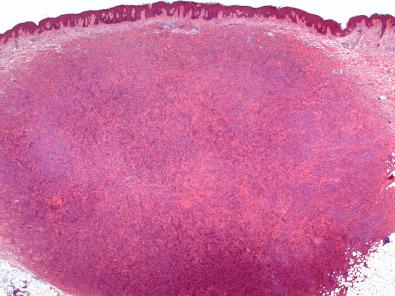
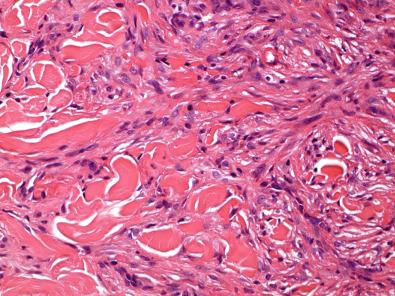
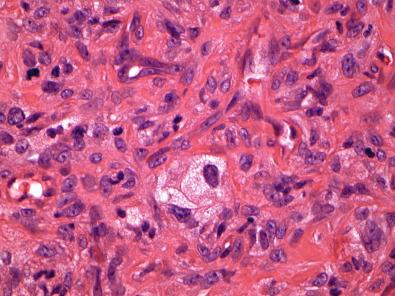
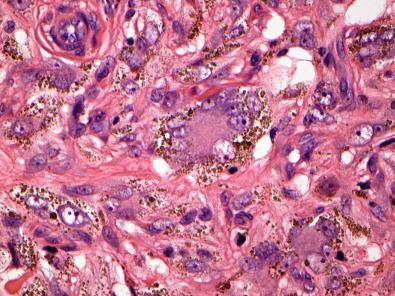
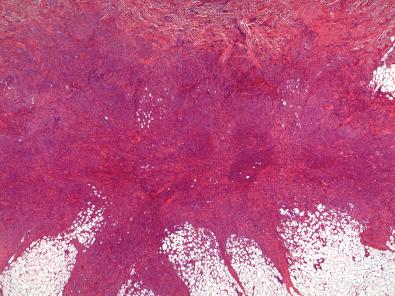
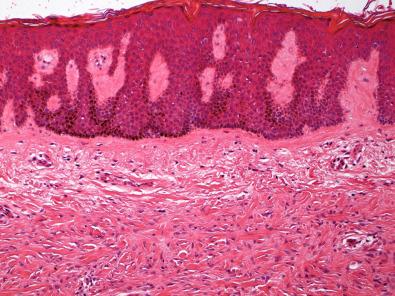
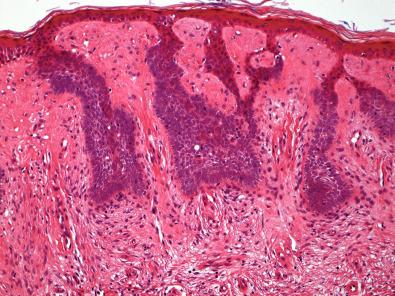
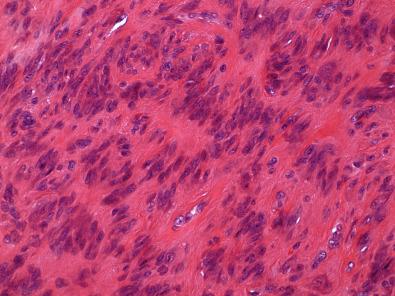
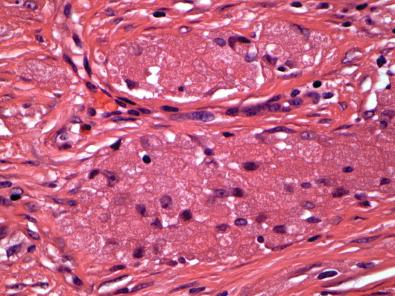
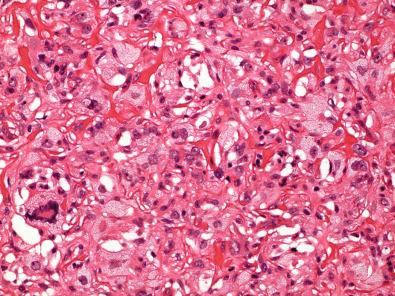
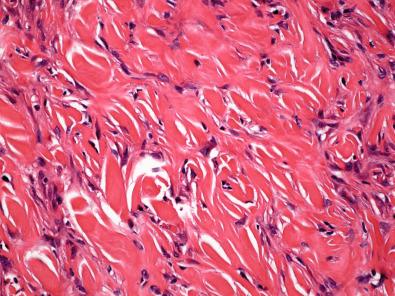
By immunohistochemistry, smooth muscle actin (SMA) or muscle-specific actin expression is seen in a significant subset of tumors ( Fig. 15.12A ). Expression of CD34 is a rare phenomenon present in approximately 5% of tumors, but S-100 protein or desmin expression is not a feature. Tumors are often populated by S-100 protein or factor XIIIa–positive dendritic cells (see Fig. 15.12B ).
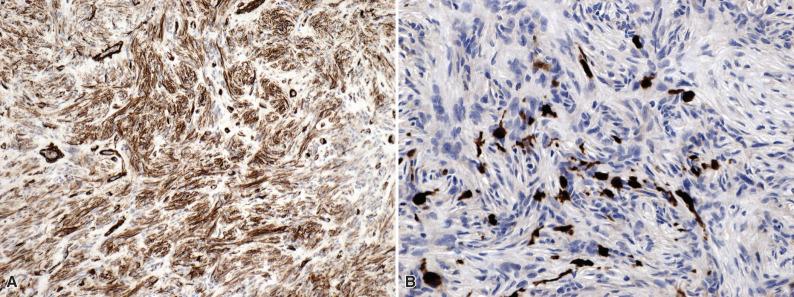
By far the most important differential diagnosis is dermatofibrosarcoma protuberans (DFSP). In contrast to dermatofibroma, the tumor cells in DFSP appear more monotonous and show a more pronounced storiform arrangement. Although CD34 positivity and extension into subcutis may be a particular pitfall in dermatofibroma, subcutaneous involvement is only focal and superficial and does not show the characteristic honeycomb infiltration of adipose tissue as seen in DFSP. Dermatofibroma can be mistaken for a scar, but the horizontal fibrosis containing vertically oriented vessels are histologic clues to the latter diagnosis. The clinical history may also be helpful in this distinction. Pilar leiomyoma and dermatomyofibroma also show some morphologic overlap with dermatofibroma. Dermatofibromas show a more haphazard rather than fascicular arrangement of tumor cells. In addition, leiomyoma expresses desmin and h-caldesmon by immunohistochemistry . Dermatomyofibroma forms a plaque composed of long fascicles aligned in parallel with the overlying epidermis. Myofibroma/myopericytoma typically shows biphasic morphology with primitive-appearing cells as well as nodules of more myoid spindle cells. The tumors are more cellular and well circumscribed, and they often show a distinctive perivascular growth pattern. Neurofibromas show a better demarcated growth pattern and contain characteristic uniform spindle cells with wavy nuclei, which are positive for S-100 protein by immunohistochemistry. The hemosiderotic variant can be mistaken for sclerosing blue nevi, as well as patch- or plaque-stage Kaposi sarcoma. Sclerosing blue nevi are characterized by the presence of pigmented dendritic melanocytes, which can be confirmed by the presence of melanin pigment and S-100 protein and/or HMB-45 immunohistochemistry. Kaposi sarcoma is an ill-defined and infiltrative tumor. Spindle cells are positive for endothelial markers as well as human herpesvirus 8.
Fibrous histiocytomas are benign mesenchymal tumors. Except for specific variants (see subsequent discussion), excision is curative and recurrences are exceptional. However, cellular, aneurysmal, and atypical fibrous histiocytoma are associated with an approximately 20% risk of nondestructive local recurrence if incompletely removed. Metastases are exceptionally rare.
Fibrous histiocytoma is the most common cutaneous mesenchymal neoplasm
Fibrous histiocytoma shows a wide histologic spectrum, and multiple variants are recognized
All variants (except epithelioid) share characteristic histologic features, including lateral collagen entrapment and overlying epidermal hyperplasia
Infiltration of superficial subcutis is not uncommon and does not affect prognosis
Clinical behavior is benign, but some variants (cellular, aneurysmal, and atypical) are associated with nondestructive local recurrence in 20% of cases
Cellular benign fibrous histiocytoma is an uncommon variant, representing approximately 5% of all fibrous histiocytomas. It shows a predilection for males and occurs predominantly on the extremities as well as on the head and neck. The tumor presents as a nodule. Tumors are frequently larger than typical dermatofibromas. They have a tendency for local recurrence in 20% of cases, and very rare distant metastases have been reported.
Histologically, cellular benign fibrous histiocytomas are characterized by increased cellularity in the central aspect ( Fig. 15.13 ). They are composed of longer and more tapering spindle cells containing larger amounts of eosinophilic cytoplasm ( Fig. 15.14 ). Tumor cells show a fascicular growth pattern, and mitotic figures may be apparent. Extension into superficial subcutis is frequently observed, and central necrosis may be observed in approximately 10% of cases. As in common dermatofibroma, tumor cellularity is reduced toward the periphery, where it shows the characteristic entrapment of dermal collagen bundles, which is an important histologic clue to the correct diagnosis. However, hyperplasia of the overlying epidermis is a less consistent finding in cellular benign fibrous histiocytoma. By immunohistochemistry, tumor cells show variable staining for SMA in nearly all cases. Focal desmin expression may be seen in 32% of cases, but expression of CD34 is rare (5%). S-100 protein is consistently negative.
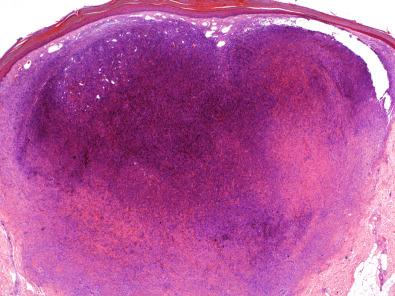
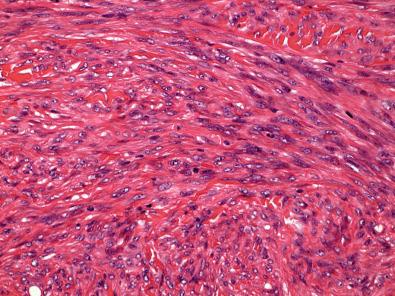
Due to their fascicular growth pattern, differentiation from the fibrosarcomatous variant of DFSP or an atypical intradermal smooth muscle neoplasm (AISMN) may be difficult. The presence of peripheral entrapment of collagen bundles, lack of invasion of deeper subcutis, and the absence of CD34 staining help distinguish cellular benign fibrous histiocytoma from DFSP. Furthermore, tumor cells in cellular benign fibrous histiocytoma lack the brightly eosinophilic cytoplasm and cigar-shaped nuclei characteristic of smooth muscle tumors. Limited (if any) desmin expression and the lack of h-caldesmon further exclude smooth muscle differentiation. Other cellular spindle cell tumors such as spindle cell melanoma and spindle cell squamous cell carcinoma should also be considered. Immunohistochemistry for S-100 protein and keratins easily resolves this diagnostic problem. Clues to a diagnosis of nodular fasciitis include a short clinical history as well as specific morphologic features such as myxoid stromal change and erythrocyte extravasation.
Aneurysmal benign fibrous histiocytoma presents as a brown to bluish nodule with a predilection for the extremities and trunk of middle-aged adults, with a slight female predominance. Tumors can measure several centimeters in size, and there may be a history of rapid growth. Clinically, they can easily be mistaken for melanoma or hemangioma. Analogous to cellular benign fibrous histiocytoma, the aneurysmal variant shows a tendency for local recurrence (in 20% of cases), but metastases are exceptional.
The characteristic histologic finding is the presence of blood-filled cystic and cleftlike spaces within the center of the tumor ( Fig. 15.15 ). The surrounding solid aspects show the typical features of fibrous histiocytoma, often resembling the cellular variant. Hemorrhage and hemosiderin deposition are prominent features, and mitotic activity is often present.
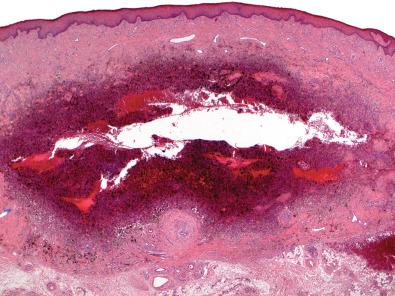
The most important differential diagnosis includes vascular tumors such as spindle cell angiosarcoma and nodular Kaposi sarcoma. Immunohistochemistry allows for straightforward separation because the spindle cells in aneurysmal benign fibrous histiocytoma lack expression of endothelial markers such as CD34, CD31, and ERG, although admixed histiocytes may be CD31 positive. Furthermore, both cutaneous angiosarcoma and Kaposi sarcoma occur in distinct clinical settings. Due to the prominent pigmentation, aneurysmal benign fibrous histiocytoma may also be mistaken for melanoma. Inspection of the periphery of the tumor, absence of an overlying in situ component, and a lack of S-100 protein expression readily resolve this diagnostic dilemma.
Atypical fibrous histiocytoma is a rare neoplasm that has previously also been referred to as pseudosarcomatous fibrous histiocytoma or dermatofibroma with monster cells . The tumor shows a predilection for the extremities of young to middle-aged adults. It presents as a polypoid or nodular tumor and may be significantly larger than common fibrous histiocytomas. Local recurrence can be a complication (in ~20% of cases), and distant metastasis with associated mortality has very rarely been documented.
The characteristic histologic feature is the presence of pleomorphic spindle cells showing nuclear hyperchromasia and often bizarre nuclei in a background of an otherwise typical fibrous histiocytoma ( Fig. 15.16 ). Pleomorphic multinucleated cells may also be present. Mitotic activity is often high and may include atypical forms. Involvement of superficial subcutis and central necrosis are additional features, similar to cellular benign fibrous histiocytoma.
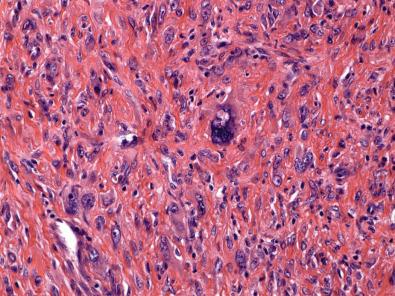
The main differential diagnostic considerations are AFX and undifferentiated pleomorphic dermal sarcoma. Histologic distinction may be difficult. In contrast to atypical fibrous histiocytoma, AFX arises on sun-damaged skin of the elderly. Although the histologic features show significant overlap, AFX typically extends to the epidermis without a grenz zone, and epidermal ulceration is common. AFX by definition is confined to the dermis. Undifferentiated pleomorphic dermal sarcomas usually occur in older adults, and they lack the peripheral collagen entrapment and epidermal hyperplasia seen in atypical fibrous histiocytoma. The differential diagnosis also includes other sarcomas with pleomorphic features such as leiomyosarcoma, as well as melanoma and carcinoma. These tumors can usually be separated by immunohistochemistry for desmin, S-100 protein, and keratins.
Dermatomyofibroma, previously also known as plaquelike dermal fibromatosis, is a rare distinctive benign cutaneous tumor showing myofibroblastic differentiation.
The tumor occurs as an occasionally discolored plaque measuring a few centimeters in size with a strong predilection for the shoulder girdle, neck, and upper arm of young female adults. Children may also be affected.
Dermatomyofibroma is based in the reticular dermis, where it grows in a plaquelike pattern ( Fig. 15.17 ). The papillary dermis is spared, but focal extension into superficial subcutis may be seen. The tumor is composed of bland and uniform spindle cells in a fascicular arrangement, oriented parallel to the skin surface ( Fig. 15.18 ). Infrequent mitoses may be seen, but cytologic atypia is not a feature.
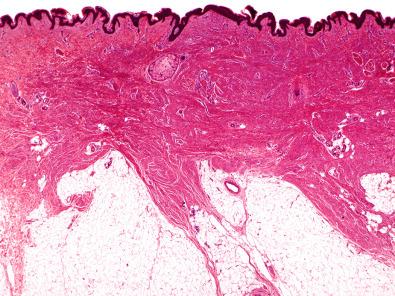
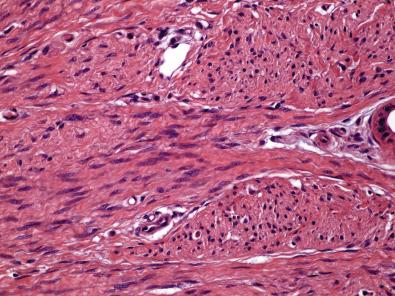
By immunohistochemistry, most cases show expression of SMA and muscle-specific actin, but desmin is negative, supporting myofibroblastic differentiation. CD34 is also focally positive in a subset of cases.
The main differential diagnosis includes plaque-type DFSP, fibroblastic connective tissue nevus, and neurofibroma. In contrast to dermatomyofibroma, plaque-type DFSP shows strong and diffuse CD34 expression. Fibroblastic connective tissue nevus lacks the uniform plaquelike architecture of dermatomyofibroma, instead being composed of disorderly bundles of bland spindle cells in the dermis and subcutaneous tissue ( Fig. 15.19 ); CD34 is usually positive, and SMA expression is at most weak and focal. Neurofibroma can be separated by immunohistochemistry for S-100 protein. Rare hemorrhagic cases mimic plaque-stage Kaposi sarcoma, which would, however, show positive staining for endothelial markers and human herpesvirus 8.
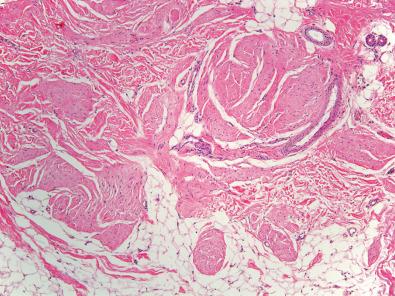
The clinical behavior is benign. Local excision is curative.
The spectrum of superficial benign smooth muscle tumors includes pilar leiomyoma and angioleiomyoma, in addition to leiomyomas of genital sites and the nipple and areola. Only pilar leiomyoma is discussed in this section. Genital smooth muscle tumors are discussed in Chapter 17 .
Pilar leiomyoma usually affects young adults. Lesions may be multiple or less frequently solitary. Multiple pilar leiomyomas affect the limbs and trunk. Lesions often present as painful papules measuring less than 1 cm in diameter. A positive family history with an autosomal dominant trait can be elucidated in a minority of patients, and females may also develop multiple uterine leiomyomas. The familial disorder may be complicated by the development of papillary renal cell carcinoma (hereditary leiomyomatosis and renal cell cancer syndrome [HLRCC]). In contrast, solitary pilar leiomyomas show a strong predilection for the limbs. They present as larger plaques with a predilection for males.
Pilar leiomyoma is a dermal-based tumor ( Fig. 15.20A ), but focal involvement of the superficial subcutis may occasionally be seen. Tumors are ill-defined and composed of interweaving fascicles of spindle cells containing blunt-ended, cigar-shaped nuclei with brightly eosinophilic cytoplasm characteristic of smooth muscle differentiation ( Fig. 15.21 ). At the periphery, tumor cells merge with surrounding collagen bundles. A nodular and well-circumscribed growth pattern is less frequently observed. Mitotic activity is scarce, but scattered cells showing degenerative nuclear atypia reminiscent of symplastic uterine leiomyoma may be seen. The overlying epidermis may be hyperplastic.
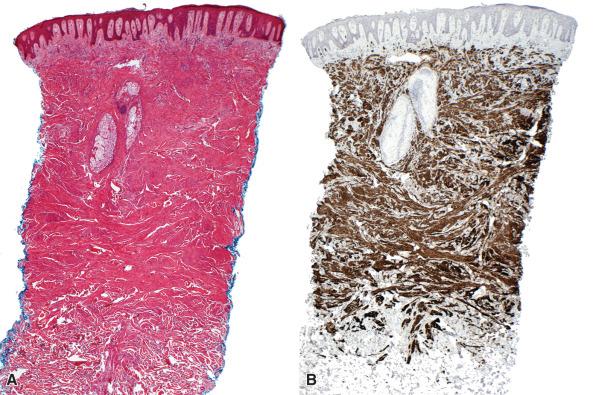
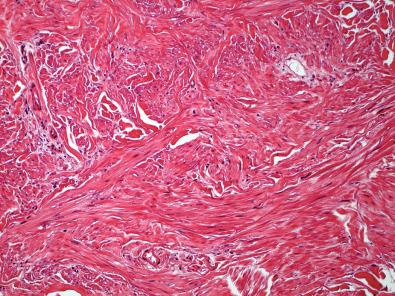
Tumor cells show strong, diffuse reactivity for SMA, desmin, and h-caldesmon (see Fig. 15.20B ).
The autosomal dominant syndrome of multiple pilar and uterine leiomyomas as well as papillary renal cell carcinoma (HLRCC) is caused by germline mutations in the fumarate hydratase (FH) gene on chromosome 1q42.3–43. Although involved in the tricarboxylic acid (Krebs) cycle, this gene also functions as a tumor suppressor gene in this context.
AISMNs are characterized by the presence of cytologic atypia and increased mitotic activity (see later discussion). Metastatic leiomyosarcoma to the skin is typically well circumscribed, and nuclear atypia and a high mitotic rate are diagnostic features. DFSP lacks the fascicular architecture and cytoplasmic eosinophilia of pilar leiomyoma, and CD34 and desmin staining resolves this diagnostic consideration.
Local excision is curative. Recurrence is exceptional.
AISMN is often referred to as cutaneous leiomyosarcoma . However, when the tumors are confined to the dermis, they may recur locally but do not metastasize. The “sarcoma” designation is therefore inappropriate unless there is invasion of subcutaneous tissue.
AISMN affects middle-aged to elderly adults, with a striking male predilection (male-to-female ratio of nearly 5 : 1). The trunk and lower limbs are most often involved. Most tumors range from 1 to 2 cm in size. AISMN typically presents as a slowly growing, occasionally painful nodule or mass.
Similar to pilar leiomyoma, AISMN is based in the dermis and usually shows a predominantly infiltrative growth pattern, with fascicles of spindle cells ramifying between dermal collagen bundles ( Figs. 15.22 and 15.23 ). In areas, a nodular architecture may be seen (see Fig. 15.22 ). Only very limited involvement of the superficial subcutis with a pushing border is acceptable for the designation AISMN. The spindle cells contain blunt-ended (cigar-shaped) nuclei and brightly eosinophilic cytoplasm, with well-defined cell borders, typical of smooth muscle cells. The presence of nuclear atypia, which is usually mild to moderate, and mitotic activity distinguish AISMN from conventional pilar leiomyoma ( Fig. 15.24 ). Epithelioid cytomorphology is rare. Necrosis is uncommon. Recurrent tumors more often show a nodular growth pattern, marked nuclear atypia, a higher mitotic rate, and necrosis. Overlying epidermal hyperplasia may be seen.
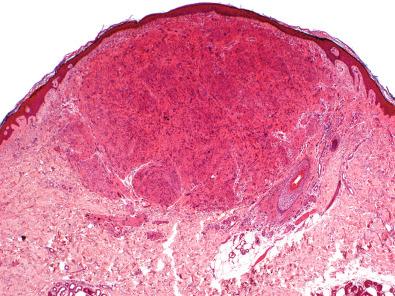
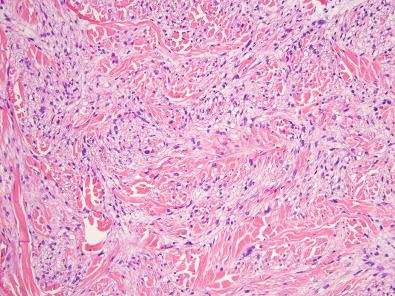
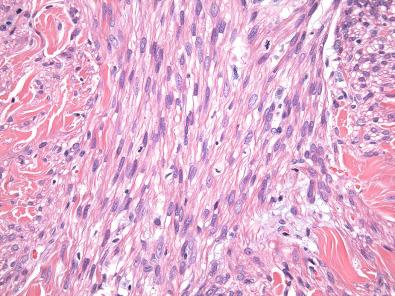
Nearly all tumors are positive for SMA, desmin, and h-caldesmon. Focal staining for keratin is observed in approximately 50% of cases. CD34, S-100 protein, HMB-45, and melan A are consistently negative.
The main differential diagnosis includes pilar leiomyoma, metastatic leiomyosarcoma, cellular benign fibrous histiocytoma, and atypical fibrous histiocytoma. In contrast to pilar leiomyoma, which often presents as multiple lesions, AISMN is solitary. Pilar leiomyoma lacks nuclear atypia and more than occasional mitotic figures. Metastatic leiomyosarcoma shows a well-circumscribed growth pattern without the infiltrative margins of primary intradermal smooth muscle tumors. Cellular benign fibrous histiocytoma may share expression of SMA and desmin by immunohistochemistry, but it lacks the well-defined bundles, blunt-ended nuclei, nuclear atypia, and bright cytoplasmic eosinophilia of AISMN. Atypical fibrous histiocytoma contains scattered cells with nuclear atypia and pleomorphism but, in contrast to AISMN, generally shows a mixed fascicular and storiform architecture, and the tumor cells are more heterogeneous with pale cytoplasm. Strong desmin and h-caldesmon expression distinguish smooth muscle tumors from atypical fibrous histiocytoma. The rare tumors that arise on the head and neck should be distinguished from spindle cell squamous cell carcinoma and malignant melanoma. A search for overlying epidermal dysplasia or a junctional component is warranted in this context. Similar to squamous cell carcinoma, AISMN is often at least focally positive for keratins, and spindle cell squamous cell carcinoma can be focally positive for SMA, although desmin and h-caldesmon are not expressed; p63 expression favors spindle cell squamous cell carcinoma over AISMN. Staining for S-100 protein and other melanocytic markers can distinguish melanoma from AISMN.
AISMN recurs locally in 20% to 30% of cases. Margin status is the only predictor of local recurrence. Complete excision with negative margins is therefore appropriate therapy. Tumors confined to the dermis do not metastasize. Tumors showing invasion into the subcutaneous adipose tissue warrant the designation “cutaneous leiomyosarcoma” ( Fig. 15.25 ) because they may rarely metastasize.
When confined to the dermis, has no metastatic potential (sarcoma designation inappropriate)
Distinctive growth pattern with bundles irregularly ramifying through dermal collagen
Distinguished from pilar leiomyoma by the presence of nuclear atypia, pleomorphism, and mitotic activity
Positive for SMA, desmin, h-caldesmon, and often keratins
Minimal extension into superficial subcutis with a pushing border is acceptable
When infiltrates subcutaneous adipose tissue, there is a small risk of metastasis; the designation “cutaneous leiomyosarcoma” is appropriate
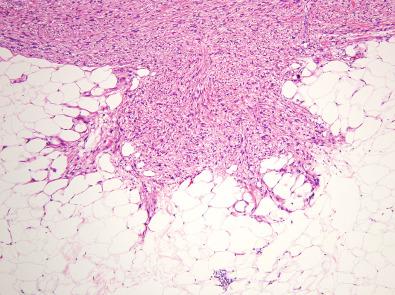
Storiform collagenoma (sclerotic fibroma) classically occurs as a solitary nodule of less than 1 cm. It has a wide anatomic distribution. Young to middle-aged adults of both genders are affected. The occurrence of multiple tumors or oral involvement may be an indicator of Cowden syndrome (PTEN hamartoma tumor syndrome). Recognition of this association is important for early detection and treatment of associated visceral malignancies, mainly affecting the breast, thyroid, and endometrium.
The histologic appearances of storiform collagenoma are distinctive. Tumors present as well-circumscribed nodules within the dermis ( Fig. 15.26 ). Composed of hyalinized collagen bundles separated by prominent clefts, they contain bland-appearing spindle cells arranged in a storiform pattern ( Fig. 15.27 ). Similar tumors containing bizarre-shaped multinucleated giant cells have been referred to as giant cell collagenoma .
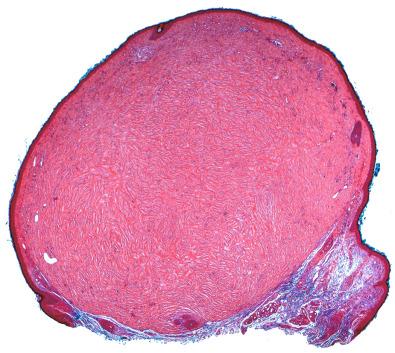
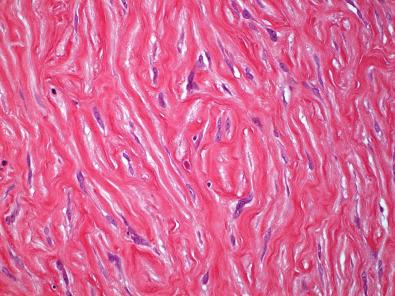
Spindle cells may be positive for CD34 but are negative for smooth muscle markers, S-100 protein, and epithelial membrane antigen (EMA) ( Fig. 15.28 ).
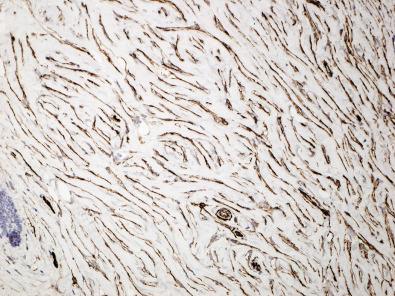
The main differential diagnosis includes perineurioma, which can be excluded by a lack of EMA expression in storiform collagenoma. Investigators have reported histologic features reminiscent of storiform collagenoma following inflammatory conditions such as folliculitis, and some examples of storiform collagenoma may represent long-standing dermatofibromas.
The behavior of storiform collagenoma is entirely benign. Simple excision is curative.
Solitary circumscribed neuroma was initially reported as palisaded encapsulated neuroma. However, the former designation is preferred because it more accurately reflects the features of this benign neural tumor, which shows only variable nuclear palisading and is at most only partially encapsulated.
Solitary circumscribed neuroma is not uncommon, with a strong predilection for the central face of middle-aged adults with an equal gender distribution. The lips and oral cavity may also be affected. It presents as a solitary, skin-colored papule measuring up to 0.5 cm in diameter. It is not associated with neurofibromatosis or other inherited syndromes.
Solitary circumscribed neuroma is located within the dermis and presents as a well-circumscribed tumor composed of spindle cells showing schwannian differentiation and numerous intratumoral axons ( Fig. 15.29 ). Spindle cells are arranged in short fascicles and contain wavy nuclei lacking atypia ( Fig. 15.30 ). Nuclear palisading reminiscent of Verocay bodies may occasionally be observed. Encapsulation is at most partial, and in particular the superficial aspect of the tumor appears to merge with the surrounding dermis ( Fig. 15.31 ). Plexiform growth and epithelioid cytomorphology have been reported but are rare.
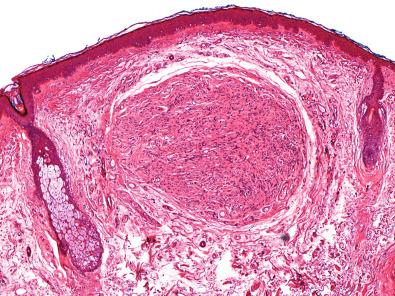
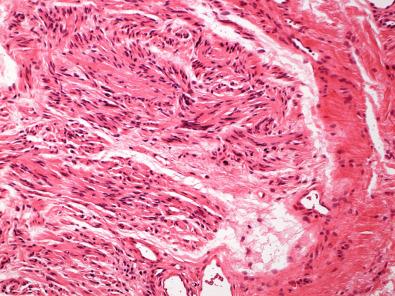
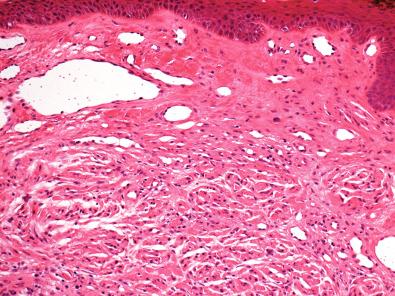
Spindle cells are diffusely positive for S-100 protein, and numerous intratumoral axons are highlighted by neurofilament protein ( Fig. 15.32A and B ). The partial capsule contains EMA-positive perineurial cells (see Fig. 15.32C ).
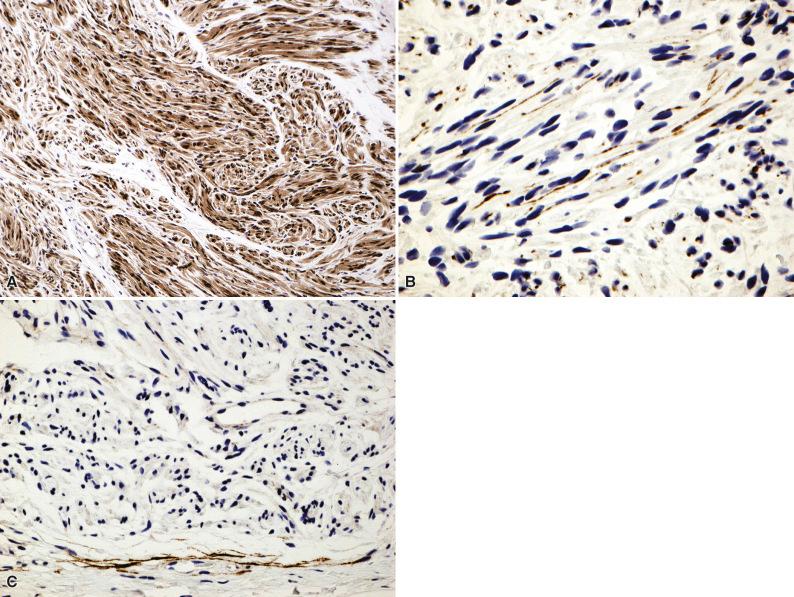
The clinical and histologic features are quite characteristic. Schwannoma may occasionally present as a dermal tumor. However, schwannomas are encapsulated, with hypocellular, myxoid areas and hyalinized blood vessels, and they are largely devoid of intratumoral axons. Neurofibromas are not as sharply circumscribed, and tumor cells show a less fascicular architecture. Solitary circumscribed neuroma may be mistaken for a smooth muscle neoplasm. It can easily be distinguished by S-100 protein and desmin immunostains.
The clinical behavior is entirely benign. This tumor does not recur.
DFSP is a locally aggressive tumor with significant potential for local recurrence but no metastatic risk in its conventional form. It shows a morphologic spectrum; in particular, recognition of the fibrosarcomatous variant is important because it is associated with acquisition of metastatic potential. Furthermore, DFSP is closely related to giant cell fibroblastoma (see subsequent discussion). This notion is supported by the finding that both histologic patterns can be found in a single tumor, and both tumors show identical immunohistochemical as well as cytogenetic findings.
DFSP is a rare neoplasm with an incidence of two to four new cases per million per year. Young adults in the second to fourth decade are predominantly affected, but presentation in childhood and congenital onset have been documented. There is a slight male predominance. Tumors show a predilection for the trunk and extremities, and the head and neck area is less frequently affected. The characteristic clinical presentation is of a large, multinodular tumor measuring several centimeters in diameter and showing red to bluish discoloration. Tumors are slow growing, and frequently there is a history of a long-standing plaque (>10 years) prior to the development of nodular areas.
DFSP is an ill-defined and diffusely infiltrative tumor of the dermis and subcutis ( Fig. 15.33 ). The tumor is centered within the dermis and may extend to the overlying epidermis, which does not typically show the characteristic hyperplasia associated with benign fibrous histiocytoma. The tumor is composed of a uniform population of slender spindle cells; nuclear pleomorphism is absent ( Fig. 15.34A ). Tumor cells are arranged in a monotonous storiform pattern, often forming tight whorls (see Fig. 15.34B ). At the periphery of the tumor, spindle cells are frequently arranged singly, which mimics entrapment of preexisting collagen bundles seen in benign fibrous histiocytoma. The tumor shows a characteristic pattern of invasion of subcutaneous tissue. Tumor cells percolate through adipose tissue in narrow strands, leaving behind intact adipocytes and thereby creating a lacelike or honeycomb appearance ( Fig. 15.35 ). Mitotic activity in DFSP is low, usually less than 5 mitoses per 10 high-power fields. Necrosis is uncommon. Some cases show marked stromal hyalinization, which can give the tumor a deceptively bland appearance ( Fig. 15.36 ). DFSP may show a number of characteristic histologic patterns. It is important to remember that multiple morphologic patterns may be present in a single tumor and that recurrences may show different morphologic features. Furthermore, recognition of the fibrosarcomatous variant is particularly important because it is associated with adverse outcomes.
Fibrosarcomatous DFSP is composed of spindle cells in a fascicular arrangement with a characteristic herringbone appearance, usually in a background of more classical storiform DFSP ( Fig. 15.37 ). Tumor cells in fibrosarcomatous areas show more pronounced nuclear atypia, and mitotic activity is often high (10 to 20 mitoses per 10 high-power fields) ( Fig. 15.38 ). Tumor necrosis may be found. Areas of pleomorphic sarcoma may rarely be identified.
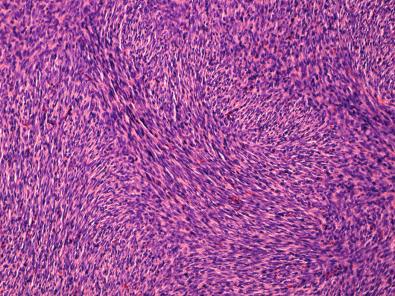
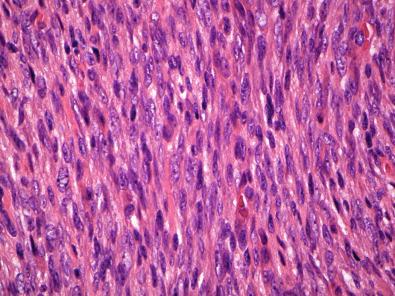
Myxoid DFSP is characterized by the presence of extensive myxoid stromal change, which may involve large parts of or even the entire tumor. Although the tumor maintains the infiltrative growth of conventional DFSP, individual tumor cells appear bland and may have a predominantly stellate morphology ( Fig. 15.39 ). They show a haphazard arrangement with loss of the typical storiform pattern. Within the tumor stroma, thin-walled vessels may be prominent (see Fig. 15.39 ).
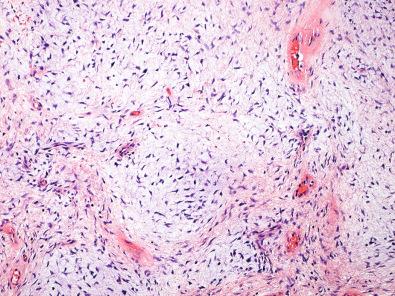
Pigmented DFSP (Bednar tumor) shows colonization of an otherwise classic DFSP by pigmented dendritic cells.
DFSP with myoid nodules often, but not exclusively, occurs in association with fibrosarcomatous transformation. It is characterized by the presence of nodules and bundles of eosinophilic spindle cells showing myofibroblastic differentiation, often adjacent to or involving the walls of blood vessels ( Fig. 15.40 ).
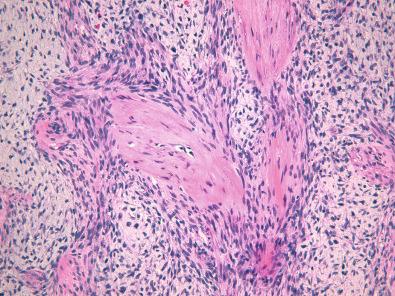
Giant cell fibroblastoma and DFSP are regarded as a morphologic spectrum of the same tumor. Areas of giant cell fibroblastoma are not infrequently identified within otherwise classic DFSP.
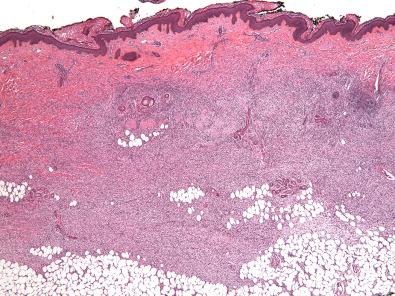
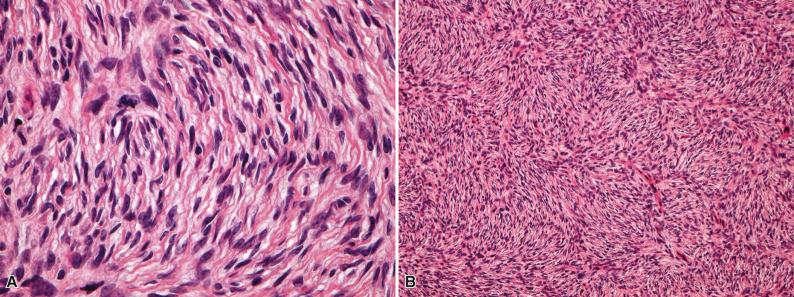
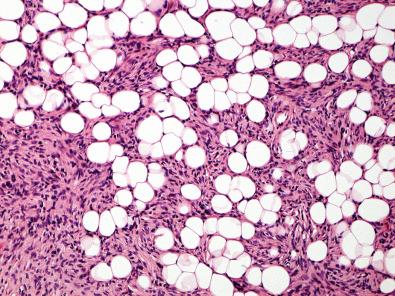
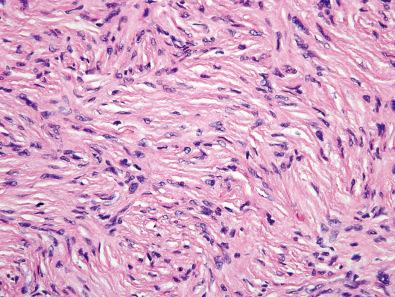
Granular cell change and nuclear palisading reminiscent of Verocay body formation are rarely observed.
Tumor cells are strongly and diffusely positive for CD34 ( Fig. 15.41 ). CD34 expression may be weaker or even absent in areas of fibrosarcomatous change and is also absent in myoid nodules, which display SMA expression in keeping with their myofibroblastic phenotype. S-100 protein and desmin are not expressed in DFSP.
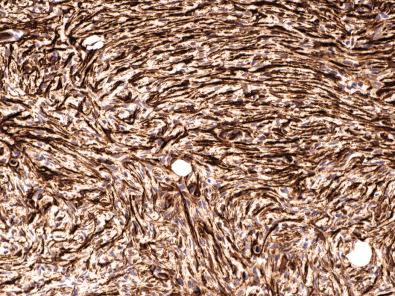
The characteristic finding in the large majority of patients with DFSP as well as giant cell fibroblastoma is a chromosomal translocation t(17;22)(q22;q13). The translocation is most frequently present in the form of a supernumerary ring chromosome, particularly in adults, whereas a linear translocation is predominantly observed in children. The t(17;22) translocation results in a fusion gene involving the collagen type 1 alpha 1 (COL1A1) gene on chromosome 17 and the platelet-derived growth factor β (PDGFB) gene on chromosome 22, thereby placing PDGFB expression under the control of the COL1A1 promoter. This finding explains susceptibility of the tumor to treatment with the receptor tyrosine kinase inhibitor imatinib mesylate.
The main differential diagnosis is benign fibrous histiocytoma (dermatofibroma), especially the cellular variant. This becomes a particular issue on superficial samples (e.g., shave biopsies), when adequate evaluation for invasion of subcutis is not possible. However, benign fibrous histiocytoma generally lacks the monotonous appearances of DFSP and overall appears better circumscribed. CD34 immunohistochemistry solves the problem in most cases. Perineurioma may show features reminiscent of DFSP, particularly when hyalinized and in small and superficial biopsies. However, perineuriomas are usually well circumscribed and composed of slender spindle cells showing characteristic long bipolar cytoplasmic processes. The characteristic immunohistochemical finding is expression of EMA, although expression of CD34 is also often observed. Dermatomyofibroma is composed of bundles of myofibroblastic spindle cells characterized by SMA positivity and lack of CD34 expression in most cases, oriented perpendicular to the skin surface, and involvement of subcutis is not a prominent feature. Superficial DFSP is difficult to distinguish from a rare CD34-positive dermal spindle cell neoplasm that has been referred to as medallion-like dermal dendrocyte hamartoma and plaquelike CD34-positive dermal fibroma . This tumor type is composed of a bandlike proliferation of uniform fibroblastic spindle cells showing a storiform growth pattern in the dermis ( Fig. 15.42 ). Although both DFSP and plaquelike dermal fibroma are CD34 positive, the latter is well circumscribed and does not infiltrate subcutaneous tissue. In difficult cases, detection of the COL1A1-PDGFB gene fusion by reverse transcriptase polymerase chain reaction (RT-PCR) or fluorescence in situ hybridization (FISH) can be used to confirm DFSP.
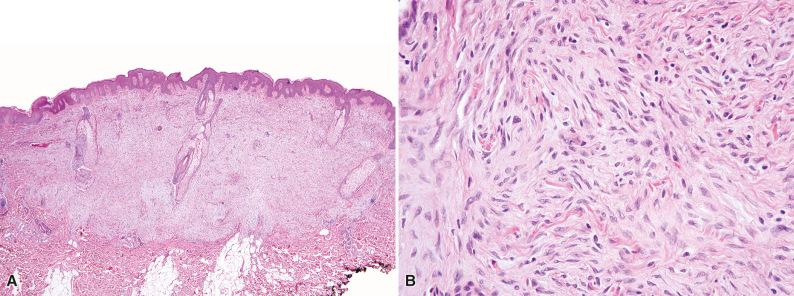
The diagnosis of fibrosarcomatous DFSP depends on the recognition of areas of more classic DFSP. If only fibrosarcomatous areas are present on a biopsy, the differential diagnosis is broad and includes spindle cell carcinoma, spindle cell melanoma, as well as various spindle cell sarcomas (including malignant peripheral nerve sheath tumor [MPNST] and monophasic synovial sarcoma, in particular). Melanoma and carcinoma can be excluded by negativity for S-100 protein or keratins. Due to CD34 positivity, spindle cell angiosarcoma merits diagnostic consideration. The clinical presentation and absence of the specific risk factors in addition to lack of vascular channel formation make this an unlikely diagnosis. MPNST very rarely affects the dermis and subcutis (mostly in patients with neurofibromatosis type 1) and is positive for S-100 protein, glial fibrillary acidic protein (GFAP), and/or SOX10 in approximately 50% of cases. Synovial sarcoma shows focal staining for EMA and keratins, and nuclear reactivity for transducin-like enhancer of split 1 (TLE1) is observed in most cases, whereas this marker is usually negative in fibrosarcomatous DFSP. Additional tumor sampling to identify areas of conventional DFSP or FISH for PDGFB is helpful for a definitive diagnosis.
The prominent myxoid change in myxoid DFSP may lead to confusion with neural tumors. Myxoid neurofibroma in particular may be a challenging differential diagnosis. Clues to the correct diagnosis include the more wavy rather than stellate nuclei in neurofibroma and lack of the diffusely infiltrative growth pattern, with the exception of diffuse neurofibroma. In addition, neurofibroma is positive for S-100 protein by immunohistochemistry. Superficial angiomyxoma may show significant morphologic overlap with myxoid DFSP, especially on superficial biopsies. This includes the stellate cellular morphology, as well as the presence of prominent thin-walled vessels and CD34 expression. However, in contrast to myxoid DFSP superficial angiomyxoma is less cellular, shows a more lobulated architecture, and lacks the characteristic honeycomb infiltration of subcutaneous adipose tissue. Myxoid liposarcoma can be distinguished by the presence of univacuolated and bivacuolated lipoblasts and abundant delicate branching (“crow's feet”) vessels. Low-grade myxofibrosarcoma shows a more lobular growth pattern, contains distinctive curvilinear blood vessels, and is characterized by more pronounced nuclear atypia and pleomorphism. Low-grade fibromyxoid sarcoma may be a particularly challenging differential diagnosis. However, these tumors usually arise in deeper tissues rather than dermis. Sharply demarcated myxoid and fibrous areas and a whorled growth pattern are characteristic features. EMA is often positive in low-grade fibromyxoid sarcoma, whereas CD34 is usually negative. MUC4 is a specific marker for this tumor type. MPNST may show similar histologic features but can be distinguished by immunohistochemical positivity for S-100 protein, GFAP, or SOX10 and location in deep soft tissue rather than the superficial location of DFSP.
Due to the presence of pigmented melanocytes, pigmented DFSP could be mistaken for spindle cell or desmoplastic melanoma. However, immunohistochemistry for S-100 protein reveals positive staining in the scattered dendritic cells only.
Classic DFSP is characterized by a significant potential for local recurrence but does not metastasize. The reported rate of local recurrence is variable and ranges from 20% to 40%. The local recurrence rate is largely influenced by adequacy of surgical excision, and wide local excision with excision margins greater than 4 cm appears to be most effective in preventing local recurrence. Mohs micrographic surgery has also been proposed more recently in the treatment of DFSP and may be beneficial at anatomically sensitive sites where wide margins cannot be achieved without significant morbidity or loss of function. Published data appear promising, especially when combined with evaluation of margins on paraffin-embedded sections (modified Mohs micrographic surgery). Treatment with imatinib mesylate can result in partial or complete tumor regression, which is helpful in anatomic sites where surgical excision with negative margins is difficult.
Although the clinical behavior of variants such as myxoid and pigmented DFSP are comparable to conventional DFSP, the presence of fibrosarcomatous change is associated with an adverse prognosis. Fibrosarcomatous DFSP is associated with a higher risk of local recurrence (up to 60%), as well as a small risk of distant metastasis (10% to 15%) and death from disease.
Locally aggressive and destructive tumor with a specific translocation t(17;22)
Tumor extent is often much greater than clinically appreciable
Treatment of choice is wide local excision
Distinctive morphologic variants are recognized
Different morphologic patterns can occur in a single tumor
Recurrences may show different morphologic features
Giant cell fibroblastoma is a closely related tumor that shares the same immunohistochemical features and translocation as DFSP
Although conventional DFSP does not metastasize, the fibrosarcomatous variant is associated with a 10% to 15% risk of distant metastasis
Giant cell fibroblastoma is a rare tumor that predominantly affects children younger than 10 years of age, with a male predominance of 2 : 1. However, the tumor affects people of all ages, and presentation in adults may occasionally be observed. The tumor presents as a slow-growing painless mass often measuring several centimeters. The anatomic distribution is wide, but there is a predilection for the trunk and extremities. The clinical course is characterized by a high rate of local recurrence of up to 50%, although no distant metastases have been reported to date. Similar to DFSP, treatment is therefore surgical, with wide local excision or Mohs micrographic surgery at anatomically sensitive sites.
Histologically, giant cell fibroblastoma is a poorly marginated tumor based within the dermis ( Fig. 15.43 ) and extending into subcutis, often giving rise to a honeycomb appearance ( Fig. 15.44 ). The tumor is composed of mildly pleomorphic, hyperchromatic spindle cells within a variably myxoid stromal background ( Fig. 15.45 ). Cellularity is variable, with hypercellular to hypocellular areas showing stromal hyalinization. The characteristic feature is the presence of large, irregularly shaped pseudovascular spaces lined by multinucleated giant cells ( Fig. 15.46 ). Mitotic activity is low, and necrosis is uncommon.
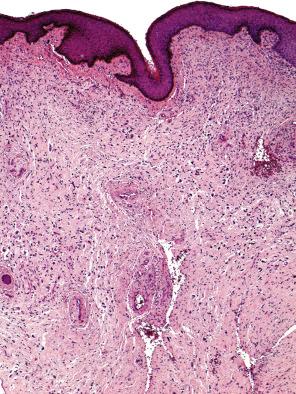
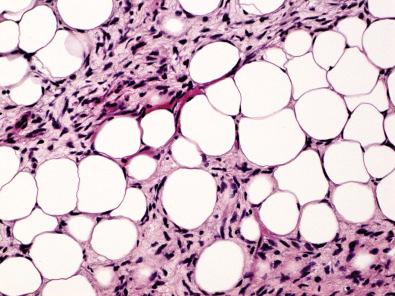
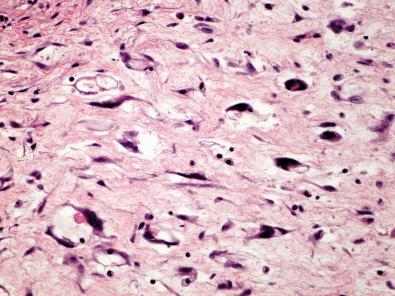
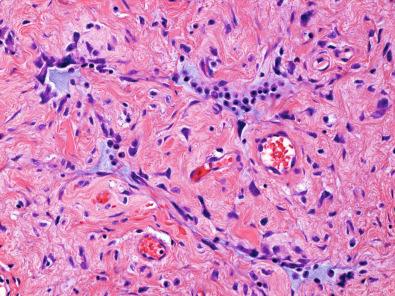
By immunohistochemistry, tumor cells express CD34 but are negative for other endothelial markers or S-100 protein.
Analogous to DFSP, there is a recurrent translocation t(17;22)(q22;q13) involving the PDGFB and COL1A1 genes.
Soft tissue perineurioma is an uncommon benign peripheral nerve sheath tumor composed of perineurial cells. Approximately 10% to 20% of soft tissue perineuriomas arise primarily in the dermis. Soft tissue perineurioma is discussed in detail in Chapter 3 .
Cutaneous perineurioma usually presents as a painless nodule. There is no gender predilection, and patients over a wide age range may be affected, with a peak in middle-aged adults. Lower limbs are most commonly involved, followed by the upper limbs and trunk. Most tumors are between 0.5 and 1.5 cm in diameter.
Perineuriomas are well-circumscribed but unencapsulated tumors and may extend to the epidermis ( Fig. 15.47 ). The tumors are composed of bland ovoid to spindled cells with slender nuclei arranged in a storiform to whorled architecture ( Fig. 15.48 ). The tumor cells contain elongated cytoplasmic processes ( Fig. 15.49A ). The stroma may be collagenous or myxoid. Mitotic activity is low, and necrosis is absent.
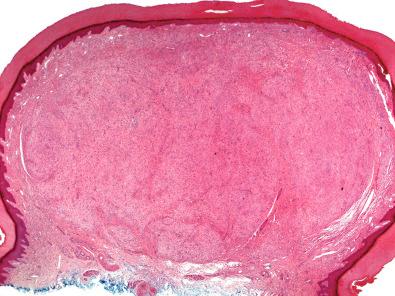
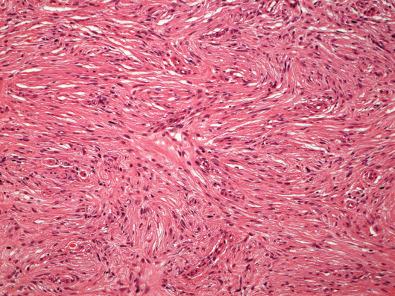
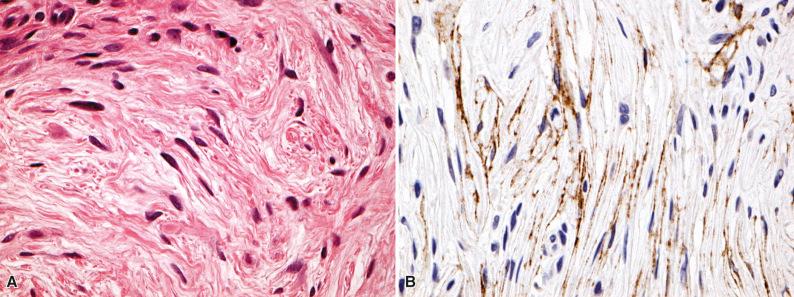
Perineuriomas are characteristically positive for EMA (see Fig. 15.49B ), although staining may be focal and weak. CD34 is also positive in most cases and may be more extensive than EMA. Both EMA and CD34 often highlight the delicate cytoplasmic processes. A subset of cases shows reactivity for the tight junction–associated protein claudin-1. SMA may be focally positive in occasional cases. S-100 protein, GFAP, and desmin are consistently negative.
The main differential diagnostic consideration for perineurioma is DFSP, especially in superficial shave biopsies. Although both tumor types show a storiform architecture and express CD34, perineuriomas are well circumscribed and are positive for EMA.
Cutaneous perineuriomas are benign and do not recur.
In recent years, benign nerve sheath tumors composed of an intimate admixture of Schwann cells and perineurial cells have been recognized. Most hybrid schwannoma/perineuriomas involve superficial soft tissues. These tumors are not associated with neurofibromatosis type 1.
Hybrid schwannoma/perineurioma affects patients in a wide age range, with a peak in young to middle-aged adults, and has an equal gender distribution. Patients present with a painless nodule or mass. The tumors occur over a wide anatomic distribution. Most tumors are between 1 and 5 cm in size.
Histologically, hybrid schwannoma/perineurioma is well circumscribed but unencapsulated ( Fig. 15.50 ). The tumor is composed of plump spindle cells with tapering nuclei and palely eosinophilic cytoplasm, in a storiform, whorled, and lamellar architecture ( Fig. 15.51 ). Under high magnification, a subset of cells with more slender nuclei and delicate cytoplasmic processes can be appreciated ( Fig. 15.52 ). The tumor may show degenerative nuclear atypia, similar to ancient schwannoma. Mitotic activity is scarce.
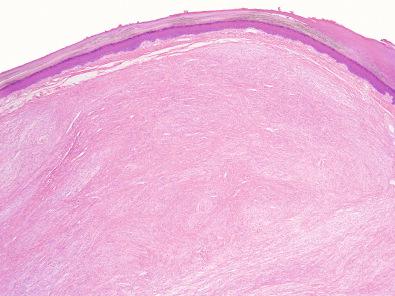
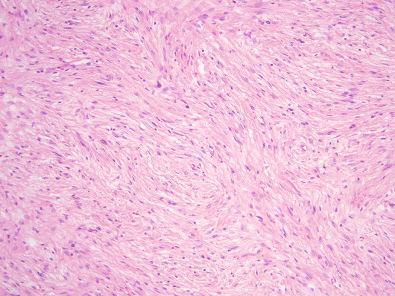
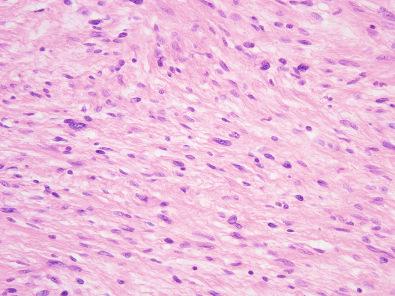
S-100 protein is positive in the Schwann cells ( Fig. 15.53A ), which usually constitute 60% to 70% of cells in hybrid schwannoma/perineuriomas, whereas EMA and CD34 are positive in perineurial cells (see Fig. 15.53B ). Most tumors also express GFAP and claudin-1.
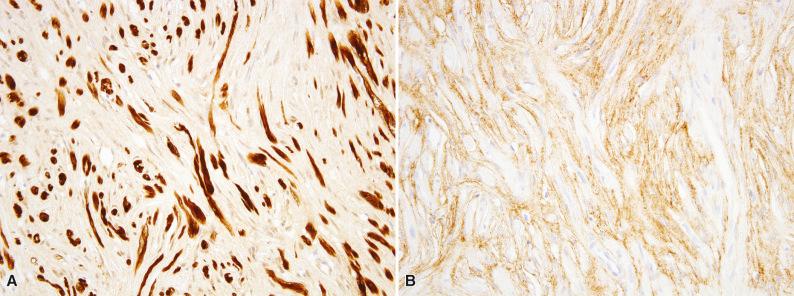
The differential diagnosis includes other benign nerve sheath tumors and low-grade MPNST. Schwannomas typically show alternating hypercellular and hypocellular areas with perivascular hyalinization, and they are diffusely positive for S-100 protein. Schwannomas are encapsulated; the perineurial capsule is positive for EMA, but EMA is negative within the tumor, in contrast to hybrid schwannoma/perineurioma. Neurofibromas lack the storiform to whorled growth pattern of hybrid schwannoma/perineurioma and are less uniformly cellular. Both tumor types show extensive staining for S-100 protein, but neurofibromas are generally negative for EMA or at most show focal staining and contain scattered neurofilament protein–positive axons. Soft tissue perineurioma is the closest histologic mimic, showing similar architectural features, but is composed of a pure population of EMA-positive perineurial cells and lacks the plumper S-100 protein–positive Schwann cells. MPNST often shows varying cellularity with accentuation around blood vessels, nuclear atypia, and mitotic activity. MPNST rarely shows strong, diffuse staining for S-100 protein, and EMA is usually negative.
Hybrid schwannoma/perineurioma is benign and only rarely recurs locally. It does not metastasize.
Become a Clinical Tree membership for Full access and enjoy Unlimited articles
If you are a member. Log in here